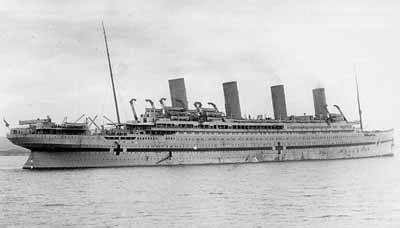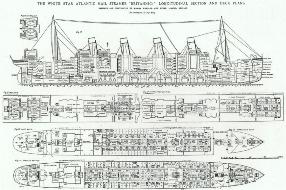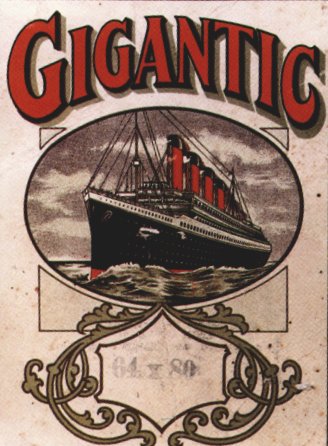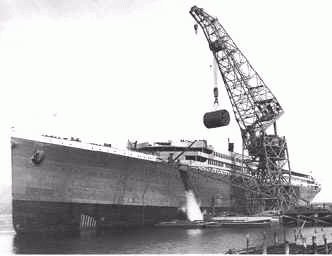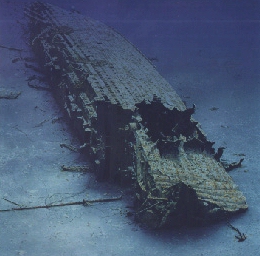Harland & Wolff
Ships
|
Cunard Ships: |
|
other Ships |
RMS BRITANNIC or HMHS BRITANNIC
The Olympic and Titanic have been built. The HMHS (His Majesty's Hospital Ship) Britannic was the third "wonder ship" to be built. Originally, the ship was to be named "Gigantic," but due to the loss of the Titanic, her name was changed to Britannic. The White Star Line knew if they were to keep ahead in the race across the Atlantic the new liner would have to be more magnificent than her older sisters. Due to the sinking of the Titanic, large scale alterations would have to be made to her design. She could not sink in under 3 hours. She must carry enough lifeboats to accommodate every passenger and crew member.
Britannic was being constructed in 1913. Her structure ran 852 feet (longer than the Olympic). She was fitted with a double skin hull. It ran for the full length of the boiler and engine room compartments. An extra bulkhead was added to make 17 compartments and five of them were extended to the Bridge deck some 40 foot above the waterline. These modifications should in theory prevent her from sinking in under three hours. The boiler room and engine rooms were more or less identical to the Olympic except that Britannic turbine engines could generate18,000 horse power. The engines were not built by John Brown & Co as in the case for Olympic but were built by Harland & Wolff. Her stern would differ from the Olympics because the aft shelter deck was enclosed so that the third class passengers could enjoy a covered area of exterior deck. The third class smoking room was placed above their general room giving the impression that the stern was much bigger.
Another striking difference was the layout of the lifeboats. She was designed to carry 48 open lifeboats. Forty-six of them would be 34 foot long (making them the largest lifeboats ever placed on a ship before.) Two of the 46 would be motor propelled and would carry wireless sets for communications. The other two were 26 foot cutters placed at both sides of the bridge. Essentially, the interior of the ship would not differ from the Olympic and Titanic. The builders added extra delights throughout the ship for every class. The second class were given a gymnasium and many of her private room were fitted with private bathrooms. 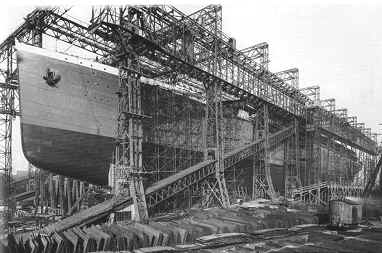
On the 26th February 1914 the Britannic was ready for launching. The weather was grim but the officials plodded on. At 11.10 a.m. a rocket signalled the commencement of the ceremony and the workforce removed the blocks keeping the hull from slipping into the water. At 11.15 with the help of 20 tonnes of tallow, train oil and soft soap she moved down the slipway. She took 81 seconds to stand afloat in the water.
Following the successful launch she was towed to the Abercon Basin to start her fitting. She was pulled by the tugs "Herculaneum," "Huskisson," "Hornby," "Alexandra" and the "Hercules." The British press were in favour of the ship and described her as "a twentieth Century ship in every sense of the word " and "the highest achievement of her day in the practise of ship building and marine engineering." Hundreds of workmen commenced the task of fitting her out. Electricians, plumbers and carpenters all played a crucial part. To the White Star Line, progress was too slow and poor. On the 2nd July 1914 they announced that Britannic would not be ready for her maiden voyage until early spring 1915. Amongst the reason for delay was finance. Harland and Wolff was owed £585,000 from the IMM which would have made all the difference to the progress if the money could have been used on the ship. The financial problem was so great that Britannic was not completed but left for nearly a whole year. WAR BREAKS OUT In August 1914 Britain, France and Russia declared war on Germany and Austria-Hungary. This would have a dramatic effect on the life of the Britannic. Both the Olympic and Britannic were placed together in secure holdings at Belfast. The owners knew that soon the ships would be called for government duty. Both ships remained in Belfast for ten months. On the 13th November 1915, the Britannic was requisitioned by the British government as a hospital ship. Orders were given to prepare her for sea going voyages to transport wounded soldiers back home. The fixtures and fittings that were to be placed on the Britannic were stored for after the war. Instead she was fitted out to resemble a hospital. The first class dining rooms were converted into operating theatres and main wards. B deck would house the medical officers and other staff. The ship was fitted to carry 3,309 people. Because she had stood so long at Belfast major works had to be carried out to her. Her lifeboats had not totally been installed. Only five davits had been fitted and so 6 Welin type davits were installed each could load one open and one collapsible lifeboat. Also, her hull had to be repainted after standing in water for so long. It was painted in the internationally recognised colours of a hospital ship. A green band was painted on each side of the ship broken by three giant red crosses. This stood her out as a hospital ship providing her with safe passage to wherever she was going. She was given ship number 9618. The Britannic left the Irish Sea on route to Mudros on 23rd December 1915. It was her maiden voyage, quite a contrast from the maiden voyages of her sisters. Her trip was successful and indeed made several more trips until her luck ran out. THE SINKING OF THE HMHS BRITANNIC She left Southampton for her final voyage at 2.23 p.m. on the 12th November 1916. Captain Charles Bartlett (also known as the Iceberg Charlie) was given command again with his assistant Captain Harry William Dyke. The ship steamed to Naples arriving on Friday morning (17th November). She took on board more coal and water as was the usual custom. Bad weather prevented an early departure. She was secured in Naples for two days until Sunday when Bartlett decided the weather was suitable for departure. The passage seemed quite normal. Church services were held as normal to pray for the wounded and for the end of war. At 8.00 a.m. on Tuesday 21st November, Bartlett changed course for the Kea Channel with Chief Officer Robert Hume and Fourth Officer D. McTowis on the Bridge. All seemed well. Suddenly at 8.12 a.m. a loud explosion echoed around the ship. Reverend John A. Fleming , the Presbyterian Chaplain, onboard described the blast as "if a score of plate glass windows had been smashed together." Bartlett knew had had to act fast. He realised what had happened - an explosion between cargo holds 2 and 3. He also knew that the ships water tight skin extended as far as boiler room no.6 and that the blast had damaged the bulkhead between holds 2 and 3 and bulkhead hold number 1. Bartlett ordered the watertight doors closed but the doors between boiler room 5 and 6 failed to close properly. Water travelled further aft as a result which would prove fatal to the ship. It was a custom of the ship that during shift changes certain watertight door would remain open so that the crew could enter and leave the boiler rooms. Within minutes of the explosion, water was poring in so much that the ship developed a serious list to starboard. The situation was becoming more serious by the minute. Within 15 minutes after the explosion, the portholes on E deck were under water. Unfortunately, many of them were open because the nurses opened them to let fresh air circulate the wards for the benefit of the patients. Because they were open they were letting in water which added to the emergency. Meanwhile, Bartlett thought he would have enough time to beach the ship on the nearby island of Kea. However, the list to starboard and the weight of the rudder hindered the ship's progress in the water. He realised that the ship would not make the coast and ordered the engines to be stopped and the lifeboats to be lowered. A distress signal had already been called giving Britannic's position. Help was on its way from the British destroyer "Scourge" and the French tugs "Goliath" and "Polyphemus." The British auxiliary cruiser "Heroic" also replotted her course to join the rescue. The lifeboats had begun to be lowered. Captain Dyke arranged the lowering of the boats on the starboard boat deck. Fifth Officer G. Fielding swung out two boats on the portside but left them hanging six feet from the water. He realised if he dropped them the ships great propellers would suck the little boat into her wake and destroy all inside the boat. Two boats left without permission and were destroyed by the propellers.
A remarkable story was told by Mrs. Violet Jessop, one of the stewardesses on board. She had infact been onboard the Olympic when she collided with the HMS Hawke and had also been onboard the Titanic. She seemed a very fortunate lady who had the same amount of lives as a cat. As she had seen the effect of the giant propellers twice before, she jumped from the lifeboat before it was sucked into the propellers. The suction was still to great and she was pulled in. However, for some reason she was not chopped to pieces but was thrown clear of danger and when she rose to the surface she hit her head on the lifeboat but was dragged to safety by survivors in another boat.
Captain Bartlett heard of the incident and ordered the propellers to be deactivated preventing more loss. At 8.35 a.m. Bartlett gave the order to abandon ship. Three more boats were lowered quickly. The starboard side list prevented some of the boats being lowered. Bartlett sounded the ships whistle one last time. As she continued to fill with water, the Bridge soon submerged. Bartlett simply walked off the platform into the sea. Like on the Titanic, the engineers remained at their posts until the last minute before escaping through the funnel casing of the fourth stack. Britannic had not long to live. She had already begun to keel over. Survivors in the boats could hear explosions coming from her inside. Britannic finally rolled over at 9.07 a.m. There were 35 lifeboats and hundreds of people frantically swimming in the water. In 55 minutes the 48.158 ton ship had sunk. Bartlett swam to a nearby ship and quickly began co-ordinating a rescue mission to save those in the water. At 10.00 a.m. the Scourge saw the lifeboats and started to pick up survivors. The Heroic was also on the scene and doing the same. She alone picked up 494 survivors. There was a total of 625 crew and 500 medical officers on board at the time of her sinking. A total of 21 crew and 9 Officers and men of the RAMC were killed in the disaster. A much lower ratio than her sisters in mortality rates. WHAT SANK THE BRITANNIC? After she sank, several rumours and theories developed to explain how a virtually unsinkable ship could sink in under an hour. 1. She was hit by a mine. During her penultimate visit to Mudros, Britannic was seen by the German Submarine U73 under Commander Gustav Sieß. It was lurking in the deep waters of the Kea Channel on 28th October 1916. U73 laid mines for future victims. The Captain of the German sub decided to plant mines along the Kea side of the channel because he noticed that all vessels used that stretch of waters to pass. He laid two mine barriers. Each consisted of six mines. The Britannic would cross the mine barriers in future trips. The huge explosion was a direct result of hitting a mine.
2. She was sank because she was transporting weapons to allied forces. There was a conspiracy theory that the hospital ships were being misused in that they did not just carry wounded soldiers but munitions to allied forces. How did this start? On 20th October 1916, the Britannic departed to Mudros for another round trip. She arrived in Naples on the 25th October and left for Mudros at 4.42 p.m. She arrived at 8.00 a.m. on the 28th October. One of her passengers was Adalbert Franz Messany . He was a 24 year old Austrian who was in Egypt when the War broke out. As an enemy to Britain he was interned. He became ill and was taken to Mudros to be transported on the Britannic. Onboard he was able to witness the handling of packages etc and all the goings on aboard. He even spoke to some soldiers about shift changes and heard about the opening and closing of the watertight doors. Messany spoke to the authorities in Vienna. He listed 22 cases of misuse of the hospital ships. It seemed good proof that the ships were infact being misused especially when he quoted some officers aboard (Reg Tapley and Harold Hickman). They defended themselves well but the damage had already been done. As can be imagined, the German authorities would use any allegations to their advantage to destroy their enemies. If there was a conspiracy against the Britannic it could easily have resulted from the allegations made against the misuse of the ships especially if the Geneva Convention had been breached (no weapons to be carried on hospital ships - except for a permitted amount). The German fleet would not regret sinking a vessel carrying arm to their enemies. Following the sinking of the ship, the British press accused Germany of every atrocity imaginable. In January 1917 the Germans declared that they would sink any ship they thought to be an enemy. In any event, it is true that there were German sympathists in Britain. It would be easy for Germany to learn when a particular ship had left Britain and its destination. All they would have to do is send a U boat to torpedo the target. The answers to the above theories cannot properly be answered until the wreck was discovered.
WHERE IS THE WRECK? Her official position was recorded in 1947 being 2.5 nautical miles west of Angalistros Point on the Island of Makronisos. In 1960, the British Admiralty confirmed the position within a fraction of a degree. For years it was believed that the resting-place of wreck number 101502722 lay where thought. In 1975 William Tankum of the Titanic Historical Society asked Jacques Cousteau to dive to the ship and explore it. He found the ship on the 3rd December 1975. Her actual position was nearly 6.75 miles east of the Admiralty position. Where the British authorities deliberately with holding the true position form divers so that some secret could not be discovered? EXPLORING THE WRECK Cousteau returned to the wreck site in September 1976. He found that the ship lay 390 feet at the bottom of the Channel. In those days technology was not as developed today. His dives would rely on breathing apparatus not submersibles. Each dive was limited to fifteen minutes each followed by three hour decompression. Following Cousteau discovery of the ship, many questions were been asked. Was she carrying munitions? Did a torpedo or mine sink her? Was there an interior explosion? Cousteau did not find any evidence to suggest that she was carrying munitions. It is supposed that he means that he did not find any weapons on the sea bed. However, with a total dive time of six hours it is hardly surprising. He did however, notice that there a section of hull plating missing. Could this have anything to do with an explosion? Cousteau could give no answers. Probably because the technologies available to him gave him no answers. BALLARDS EXPLORATION
The wreck lay undisturbed for a further 20 years until Dr. Robert Ballard dove to the ship with state-of-the-art equipment. His mission was to pick up where Cousteau left off. The wreck would be photographed and filmed. Voyager, the remotely operated vehicle ( ROV) was connected to a 3-D imaging system to bring the ship to life. He found that the ship was actually in good condition. She lies on her starboard side at a list of about 85 degrees (except for the bow, which is more upright). There is a tear down the visible port side of the hull. Ballard noticed that some of the plating is bent upward which could explain an interior expolsion forcing the plating to explode outward rather than a mine blasting the plates inward. However, Ballard is of the opinion that the bending was caused by the impact as the ship hit the bottom of the sea floor. The rest of the ship is in remarkable condition. So much so that there is still glass over the first class staircase. Even the propellers are still in place. However, Ballard's six day exploration did not shed any light on what sank her. There was no evidence of a mine anchor. He explored a radius of 500 feet from the ship. Ballard is convinced that the tear along the hull near the well deck was a result of structural failure not an internal explosion. If so it is still not known why the ship took only 55 minutes to sink. Ballard hopes to return to the wreck someday to send a robot vehicle inside the bow section to learn more about what happened. Since his visit in 1995, the Britannic has been subjected to other expeditions who have stripped her of many of her artefacts. The desecration will probably continue because the wreck lies in international water. There has though been talk that she would become an interactive underwater museum fitted with underwater cameras which would broadcast life pictures of the ship to museums all over the world and perhaps even internet. The Greek authorities restrict the number of dives to the wreck but the damage may already have been done. |
